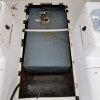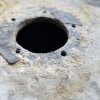- Joined
- Nov 19, 2018
- Messages
- 11
- Reaction score
- 1
- Points
- 3
- Age
- 68
- Model
- Adventure
OK, I have the fuel tank completely free except for the filler tube attached to the tank neck. I have it freed-up; it turns on the neck nipple, but won’t slide off....won’t budge! Trying not to cut the hose, so I attempted to remove the gas cap filler flange. The filler flange isn’t screwed into the glass, but has a machine screw and nuts backing it up? And there is zero access to the nuts; must have pre-installed before they put the body cap on the hull????!!!! Guess I’ll drill out the oval head machine screws and drive them through?....then cut the filler hose and snake a new one back to the tank. I was trying not to do this, so if anyone has a solution. It’s a 1996 boat, so the rubber fill tube isn’t too supple; probably just replace it? Thanks, CT






